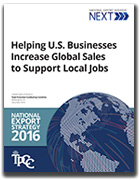 ITA Media Library
ITA Media Library
National Export Strategy, 2016 edition
Businesses attempting to close an export sale today face many hurdles, including lack of information about how to export, how to identify opportunities and buyers, how to obtain financing when their bank does not want to incur overseas risk, and how to compete with foreign companies that are supported by their own governments with both resources and advocacy. U.S. Government export promotion programs play a critical role in addressing these challenges and complementing private-sector services by filling market gaps, such as meeting the needs of small businesses and providing credit and information where there are market limitations.
To ensure coordination among these programs and develop government-wide priorities to support U.S. exporters, the President and Congress established the Trade Promotion Coordinating Committee (TPCC) in the early 1990s, consisting of leaders from 20 U.S. Government departments and agencies. Agencies outline their priorities in a National Export Strategy (NES).
This year's National Export Strategy serve as a review of results and a path forward, identifying critical areas of focus and highlighting how U.S. businesses, their employees, and their communities have benefited from the U.S. Government’s export assistance programs and policies during the past eight years through the Obama Administration's National Export Initiative (NEI) and subsequent initiative, NEI/NEXT. Federal agencies—working together and with stakeholders—helped U.S. companies win a record $239 billion in U.S. content on major projects, counseled thousands of new clients to support $55 billion in U.S. goods and services exports, financed a record number of small businesses and international deals, opened new dynamic markets, and aggressively enforced U.S. trade agreements. All of this growth was achieved despite significant economic headwinds.
- Chapter 1, "Success of the National Export Initiative," discusses U.S. export activity from 2009–15, outlines key NEI accomplishments and new programs, and explains how agencies adapted the NEI to NEI/NEXT to build a strategy reflecting emerging realities in global trade.
- Chapters 2 through 6 outline how the TPCC is enhancing trade assistance and service delivery through NEI/NEXT, laying the groundwork to help U.S. businesses decisively take advantage of opportunities unlocked by new trade agreements. Each chapter addresses a priority that responds to U.S. exporter needs:
- Improved assistance and increased connections to overseas customers
- A more streamlined export process and improved physical infrastructure
- Expanded access to export finance
- Strong local export assistance networks and ecosystems
- Market access, new trade opportunities, and enforcement of trade rules
- Chapter 7 builds on the priorities in Chapters 2 through 6 and details where U.S. trade assistance programs and policies must focus to help U.S. exporters succeed in a challenging global environment.
Economic forces at work globally make supporting U.S. exporters, particularly smaller companies, more important than ever. U.S. exporters now face new challenges compared to eight years ago.
World economic recovery since the financial crisis has been weak, falling below growth expectations each year since 2010. World economic growth slowed in 2015. The U.S. economy grew faster than most other advanced economies, and 2015 was another year of solid job growth. The unemployment rate fell from 5.6 percent to 5.0 percent during 2015. The International Monetary Fund (IMF) projects that world economic growth will be 3.1 percent in 2016, the same as in 2015. In addition, the growth of global trade has barely matched global gross domestic product (GDP) growth, after years of growing at a significantly faster rate. The IMF expects that growth in the volume of world trade will accelerate modestly in 2016. Slow growth in demand, among other factors, will present a challenging environment for U.S. exporters, making the priorities outlined in this report particularly important.

Availability
- Online: PDF Format
The International Trade Administration, U.S. Department of Commerce, manages this global trade site to provide access to ITA information on promoting trade and investment, strengthening the competitiveness of U.S. industry, and ensuring fair trade and compliance with trade laws and agreements. External links to other Internet sites should not be construed as an endorsement of the views or privacy policies contained therein. This site contains PDF documents. A PDF reader is available from Adobe Systems Incorporated.

